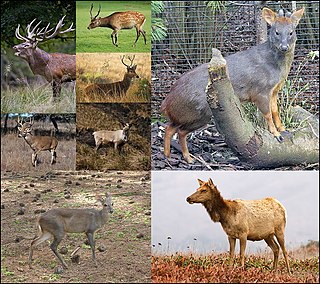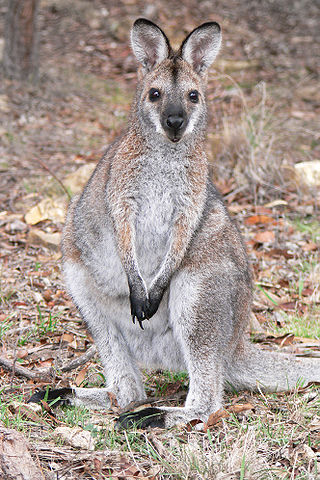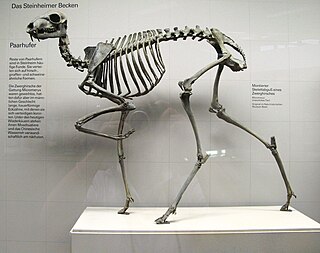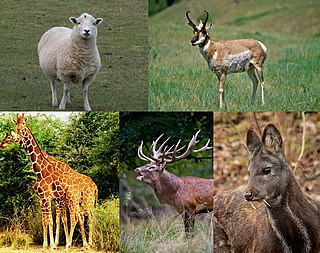
A deer or true deer is a hoofed ruminant mammal of the family Cervidae. The two main groups of deer are the Cervinae, including muntjac, elk (wapiti), red deer, and fallow deer; and the Capreolinae, including reindeer (caribou), white-tailed deer, roe deer, and moose. Male deer of all species, as well as female reindeer, grow and shed new antlers each year. In this, they differ from permanently horned antelope, which are part of a different family (Bovidae) within the same order of even-toed ungulates (Artiodactyla).

The even-toed ungulates are mammals belonging to the order Artiodactyla. They are ungulates—hoofed animals—which bear weight equally on two of their five toes: the third and fourth. The other three toes are either present, absent, vestigial, or pointing posteriorly. By contrast, odd-toed ungulates bear weight on an odd number of the five toes. Another difference between the two is that many other even-toed ungulates digest plant cellulose in one or more stomach chambers rather than in their intestine as the odd-toed ungulates do.

Macropodidae is a family of marsupials that includes kangaroos, wallabies, tree-kangaroos, wallaroos, pademelons, quokkas, and several other groups. These genera are allied to the suborder Macropodiformes, containing other macropods, and are native to the Australian continent, New Guinea and nearby islands.

The Bovidae comprise the biological family of cloven-hoofed, ruminant mammals that includes cattle, bison, buffalo, antelopes, and caprines. A member of this family is called a bovid. With 143 extant species and 300 known extinct species, the family Bovidae consists of 11 major subfamilies and thirteen major tribes. The family evolved 20 million years ago, in the early Miocene.

Ruminants are hoofed herbivorous grazing or browsing mammals that are able to acquire nutrients from plant-based food by fermenting it in a specialized stomach prior to digestion, principally through microbial actions. The process, which takes place in the front part of the digestive system and therefore is called foregut fermentation, typically requires the fermented ingesta to be regurgitated and chewed again. The process of rechewing the cud to further break down plant matter and stimulate digestion is called rumination. The word "ruminant" comes from the Latin ruminare, which means "to chew over again".

The Giraffidae are a family of ruminant artiodactyl mammals that share a common ancestor with deer and bovids. This family, once a diverse group spread throughout Eurasia and Africa, presently comprises only two extant genera, the giraffe and the okapi. Both are confined to sub-Saharan Africa: the giraffe to the open savannas, and the okapi to the dense rainforest of the Congo. The two genera look very different on first sight, but share a number of common features, including a long, dark-coloured tongue, lobed canine teeth, and horns covered in skin, called ossicones.

Moschidae is a family of pecoran even-toed ungulates, containing the musk deer (Moschus) and its extinct relatives. They are characterized by long 'saber teeth' instead of horns, antlers or ossicones, modest size and a lack of facial glands. The fossil record of the family extends back to the late Oligocene, around 28 million years ago. The group was abundant across Eurasia and North America during the Miocene, but afterwards declined to only the extant genus Moschus by the early Pleistocene.

Musk deer can refer to any one, or all seven, of the species that make up Moschus, the only extant genus of the family Moschidae. Despite being commonly called deer, they are not true deer belonging to the family Cervidae, but rather their family is closely related to Bovidae, the group that contains antelopes, bovines, sheep, and goats. The musk deer family differs from cervids, or true deer, by lacking antlers and preorbital glands also, possessing only a single pair of teats, a gallbladder, a caudal gland, a pair of canine tusks and—of particular economic importance to humans—a musk gland.

Pecora is an infraorder of even-toed hoofed mammals with ruminant digestion. Most members of Pecora have cranial appendages projecting from their frontal bones; only two extant genera lack them, Hydropotes and Moschus. The name “Pecora” comes from the Latin word pecus, which means “horned livestock”. Although most pecorans have cranial appendages, only some of these are properly called “horns”, and many scientists agree that these appendages did not arise from a common ancestor, but instead evolved independently on at least two occasions. Likewise, while Pecora as a group is supported by both molecular and morphological studies, morphological support for interrelationships between pecoran families is disputed.

The Antilocapridae are a family of artiodactyls endemic to North America. Their closest extant relatives are the giraffids. Only one species, the pronghorn, is living today; all other members of the family are extinct. The living pronghorn is a small ruminant mammal resembling an antelope.

The Cetruminantia are a clade made up of the Cetancodontamorpha and their closest living relatives, the Ruminantia.

Protoceratidae is an extinct family of herbivorous North American artiodactyls that lived during the Eocene through Pliocene at around 46.2—4.9 Mya, existing for about 41 million years.

Leptomeryx is an extinct genus of ruminant of the family Leptomerycidae, endemic to North America during the Eocene through Oligocene 38–24.8 Mya, existing for approximately 13.2 million years. It was a small deer-like ruminant with somewhat slender body.

The Palaeomerycidae is an extinct family of Neogene ruminants belonging to the infraorder Pecora. Palaeomerycids lived in Europe and Asia exclusively during the Miocene, coevolving with cervids, bovids, moschids, and tragulids there as part of a dramatic radiation of ruminants by the early Miocene.

Micromeryx is an extinct genus of musk deer that lived during the Miocene epoch. Fossil remains were found in Europe and Asia. The earliest record (MN4) of the genus comes from the Sibnica 4 paleontological site near Rekovac in Serbia.

Acerorhinus was a genus of rhinoceros of the tribe Aceratheriini endemic to Asia from the Miocene, living from 13.6—7.0 mya existing for approximately 6.6 million years.

Oriomeryx is an extinct genus of the family Moschidae, endemic to Europe from the early Miocene epoch, approximately 20 Ma. Fossils are known only from a single site in Zaragoza, Spain.

Artiofabula is a clade made up of the Suina and the Cetruminantia. The clade was found in molecular phylogenetic analyses and contradicted traditional relationships based on morphological analyses.

Bachitherium (etymology "Bach" the French locality and "θήρ" meaning "beast") is an extinct genus of Paleogene ruminants belonging to the monotypic family Bachitheriidae that lived in eastern Europe and later western Europe from the late Eocene to the late Oligocene. Previously identified as species of Gelocus, the genus was first erected in 1882 by Henri Filhol with the type species being B. curtum. Bachitherium had gone through a taxonomic history of being classified with ruminant families of the infraorder Tragulina but has since been distinguished as belonging to its own family with 6 known species based on the presence of a caniniform P1 (premolar) tooth, small tusklike I1 (incisor), short upper canines, and other dental and postcranial differences that made it an evolutionarily "advanced" traguline. It is known as the first ruminant to have appeared in Europe, although it was also not the first to appear in the western European region.

Bovoidea is a superfamily of pecoran ruminants containing the Bovidae and Moschidae. The Bovoidea today is defined in part by very specific dental and anatomical traits, and genetic research indicates that the Moschidae is sister taxon to the Bovidae.


















